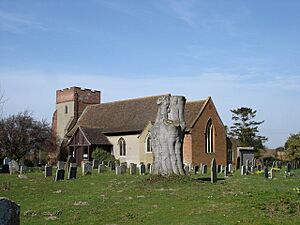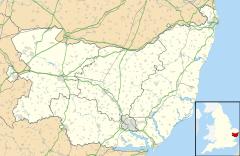Trimley St Martin facts for kids
Quick facts for kids Trimley St. Martin |
|
|---|---|
 |
|
| Population | 1,942 (2011) |
| OS grid reference | TM 274 377 |
| Civil parish |
|
| District |
|
| Shire county | |
| Region | |
| Country | England |
| Sovereign state | United Kingdom |
| Post town | Felixstowe |
| Postcode district | IP11 |
| Dialling code | 01394 |
| EU Parliament | East of England |
Trimley St. Martin is a friendly village in the Suffolk county of England. It is located in the East Suffolk area. This village sits on a narrow piece of land between two rivers, the Orwell and the Deben. This area is often called the Colneis Hundred. In 2011, about 1,942 people lived in Trimley St. Martin.
The village is next to another village called Trimley St. Mary. Both are well-known for their churches, which stand right next to each other. People say these churches were built because of an old family disagreement! St. Martin's church is the one located more to the north.
Contents
Exploring Trimley St. Martin's Past
Trimley St. Martin has a very long and interesting history. People have lived here for thousands of years!
Ancient Discoveries in Trimley
Archaeologists have found many old things in the Hams Farm area. These findings show that people lived here in prehistoric times. They also found items from the Roman and Anglo-Saxon periods. Some pieces of pottery from ancient Gaul (now France) were discovered too.
Near the village of Walton, archaeologists found evidence of old Bronze Age farms. A Roman road once passed through Trimley St. Martin. This road connected a Roman fort in Walton to the rest of Roman Britain. More recent digs have uncovered ancient ring ditches near Cavendish Grove. There is also proof of an Anglo-Saxons settlement near Hams Hall.
How Trimley Got Its Name
During the Middle Ages, this area was often visited by Viking raiders from Scandinavia. Many of them settled here. These new settlements were often named after their leaders. Over time, these names changed a lot. Trimley is a good example! Its name has been spelled in many ways, like Tremeleaia, Tremlega, and Tremlye.
Trimley in the Domesday Book
The Domesday Book was a huge survey made in 1086 by William the Conqueror. It listed all the land and property in England. This book shows that many small villages were part of Trimley back then. Places like Alteston and Grimston are mentioned. Today, their names are only remembered in places like Grimston Hall or Candlet Farm.
The Domesday Book also mentions the two churches in Trimley. It says that one church had 20 acres of land, and another had 8 acres. This shows how important the churches were even a long time ago.
Changes Over the Centuries
In the 14th century, a small village called Alston became part of Trimley St. Martin.
More recently, in 1974, a new road was built. This road, called the Trimley-Walton bypass, cut the parish in half. It was built to stop port traffic from going through the village streets. In the early 1980s, the village grew much bigger. Many new houses were built, and the population more than doubled.
Grimston Hall and Famous Explorers
Grimston Hall's History
In the 1500s, Grimston Hall was the home of Thomas Cavendish. He was a famous English explorer, often called "The Navigator." He sailed around the world!
A book from 1800, called The Suffolk Traveller, mentioned two special trees. These trees, called Ilexes (which might be Holm Oaks), were planted by Thomas Cavendish himself. There's even an old poem that talks about his love for Trimley and "the Oaks of Grimston Hall."
Pouch Meadow's Secret Spring
In 1741, another traveler named John Kirby (topographer) explored the area. He wrote about a "lane to the pouch" in Trimley. This lane led to a small meadow east of the two churches. In this meadow, there was a spring of clear water. People believed this spring was the source of a stream called Kingsfleet.
You can still see the stream flowing out from a concrete opening today. This opening was built when engineers covered most of the meadow to create the Trimley Roundabout (A14 Junction 59). During the construction, a medieval millstone was found in the stream! A path near the meadow is called CrowsWell Way. It runs between an old smock mill and the top of Pouch Meadow.
Mining for Coprolite
Trimley St. Martin and nearby villages were once very busy with Coprolite mining. Coprolite is fossilized animal waste, which was used as a fertilizer. Miners dug huge holes in the ground to find it. Landowners could earn a lot of money, about £20, for the right to mine on their land. This was a lot of money back then, enough to buy a nice house! Big companies like Packards and Fisons were involved in this industry.
The Village Hall Fire
On the night of June 19, 2013, the village hall was badly damaged by a fire. It was a sad event for the community.
Famous People from Trimley St. Martin
- Thomas Cavendish (1560–1592): An English explorer who sailed around the world.
- Maurice Norman (born 1934): A well-known footballer.
- Yvonne Drewry (1918–2007): A talented artist and printmaker.
- Arnold Allen (born 1994): A professional mixed martial artist.


